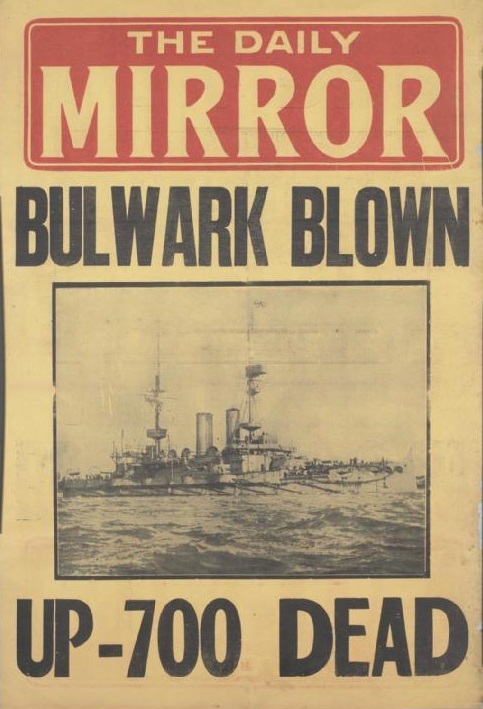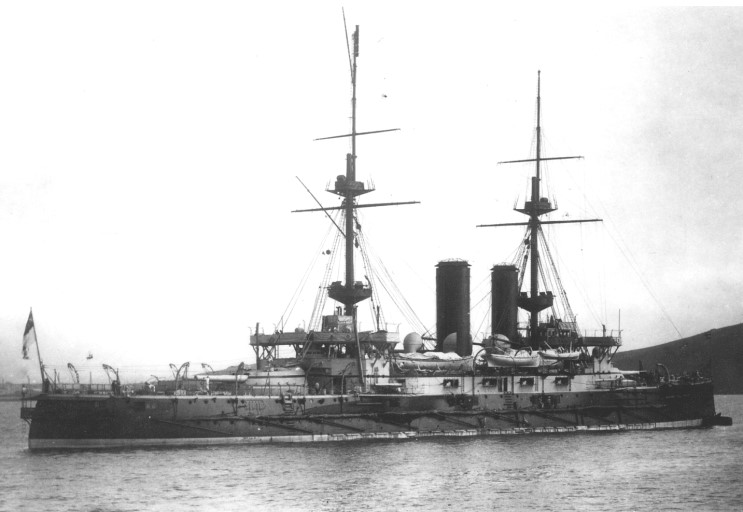As a result of helping research and write a book commemorating eleven men on our Church War Memorial who died in World War 1, www.theunforgotten.net , I discovered tragic and suspect evidence surrounding the explosion on board H.M.S. Bulwark with the loss of 51 officers and 740 other ranks. As I studied this evidence and the conclusions from both the Court of Enquiry and research published by Stuart R. Ball, Mariners Mirror Vol. 72 Issue 2 1986 ‘ Life and Death of an Edwardian Battleship – A case study of HMS Bulwark’, the cause of the explosion and the death of so many trained and experienced seamen suggested to me that the Admiralty were either misled or else chose to deliberately disguise the true reasons. Since my research also uncovered ammunition explosions on board Royal Naval capital ships during the first world war, HMS Queen Mary, HMS Invincible, HMS Defence at Jutland and HMS Vanguard and HMS Glatton at Scapa Flow and Dover respectively, I decided to interrogate findings from the Bulwark enquiry to see whether common factors existed.
The Bulwark disaster see Conclusions of Court of Enquiry, 28 November 1914, PRO ADM 116/1370 found that the storage of ammunition in the cross passages of the battleship,which was not against regulations, had created conditions for a chain reaction when cordite packages ignited. The cross passages used for moving ammunition from the magazine hoists up to the gun turrets had no protective fire doors. The dead gunnery officers were blamed for allowing the cordite packages to be kept in the passages near to bulkheads heated up by adjacent boiler rooms. The cordite, becoming unstable and producing a volatile gas was then ignited by a spark off a shell case or some other metal object. The preliminary explosion leading back immediately into the main magazine.
The initial report of the Court of Enquiry proposed that the explosion started in the main magazine but Winston Churchill, then First Lord of the Admiralty, rejected its findings. The final report pinned the blame directly on the actions of the ships crew and gunnery officers apparently discounting the fact that a high proportion of Bulwark’s ammunition, only taken on board between May and July 1914, was as much as 14 years old. The predicted life of this type of 6 ” and 12” ordnance was 30 years but only under certain conditions especially a stable temperature. The details of the shells supplied to HMS Bulwark from Lodge Hill (1914) is given in David Evans. Arming the Fleet. The development of the Royal Ordnance Yards. 1770 – 1945. English Heritage 2006. Evans comments that ‘all previous tests were of necessity only conducted on random samples and could not guard against the possibility of a poorly manufactured batch against the rest’. Some of the randomly tested samples of the ammunition taken by Bulwark was under the 10 minute limit test which was used to establish remaining life. These were retested. The findings then showed that even these samples had ‘adequate’ future life and were thought to be ‘satisfactory’.The age of the ordnance and the imperfect methods of establishing safe life as well as the probable inconsistencies caused by supply from different ordnance factories (6) makes a suspicion quite reasonable that some proportion of the ammunition was unstable before it was even loaded onto the ship. The shortage of ammunition for both the Army and the Navy during the opening months of the war surely meant that some batches even when considered dubious, would have been passed through the system if possible.
The blame for the accident could be placed on the crew of Bulwark without raising difficult questions about ordnance manufacture and current methods of testing and handling cordite in particular. The findings of the Court of Enquiry were not released to the public and were embargoed for 60 years. This suggests that the Admiralty wished to avoid debate or criticism of their munitioning practices. After the Battle of Dogger Bank in 1915 the protection of magazines and the safe handling of ammunition on Royal Naval battlecruisers had still not been addressed although on the German High Seas Fleet, due to the damage to the Seydlitz and the loss of the Blucher partly from ammunition explosions, an overhaul of routine handling practices and the fitting of fire doors between hoists and magazines was instigated.. See Kennedy Hickman. World War 1 ; Battle of the Dogger Bank (1915).http:// militaryhistory.about.com. It is arguable that had the British fleet also taken the same steps it would have suffered fewer losses amongst the battlefleet at Jutland one year later.
If the supply of poor quality and unstable cordite to Bulwark was a major contributor to the disaster how many other ships were exposed to a similar risk? As the storage of ammunition below decks in the cross corridors often close to bulkheads adjoining boiler rooms prevailed and the laborious routine checking of all cordite ‘packages’ on board overlooked, the results, both at Jutland and in other fleet actions even at Coronel later in 1914, was seriously prejudiced from the outset.
I am anxious to find advice from historians who have studied ammunition supply to the Navy in World War 1 and the Royal Ordnance controls over cordite quality and stability. Also the procedures for checking shells and cordite on board Royal Naval ships in the first 3 years of the war.
I contacted Guy Sclater R.N. Ret’d the grandson of Captain Sclater who was in command of the Bulwark when she exploded. He explained that his late mother could never talk about the tragedy or the death of her husband, although he felt certain that she considered the verdict of the 1914 Court of Enquiry unfair. For his sake and the relatives of the other officers and men blamed for the accident I would like to establish substantial evidence of the munitioning supply problems at the start of the war and the impact these might have had on the naval engagements that followed. My e mail address is,

